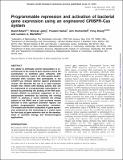Programmable repression and activation of bacterial gene expression using an engineered CRISPR-Cas system
Author(s)
Zhang, Feng; Bikard, David; Jiang, Wenyan; Samai, Poulami; Hochschild, Ann; Marraffini, Luciano A.; ... Show more Show less
DownloadBikard-2013-Programmable repress.pdf (3.049Mb)
PUBLISHER_CC
Publisher with Creative Commons License
Creative Commons Attribution
Terms of use
Metadata
Show full item recordAbstract
The ability to artificially control transcription is essential both to the study of gene function and to the construction of synthetic gene networks with desired properties. Cas9 is an RNA-guided double-stranded DNA nuclease that participates in the CRISPR-Cas immune defense against prokaryotic viruses. We describe the use of a Cas9 nuclease mutant that retains DNA-binding activity and can be engineered as a programmable transcription repressor by preventing the binding of the RNA polymerase (RNAP) to promoter sequences or as a transcription terminator by blocking the running RNAP. In addition, a fusion between the omega subunit of the RNAP and a Cas9 nuclease mutant directed to bind upstream promoter regions can achieve programmable transcription activation. The simple and efficient modulation of gene expression achieved by this technology is a useful asset for the study of gene networks and for the development of synthetic biology and biotechnological applications.
Date issued
2013-06Department
Massachusetts Institute of Technology. Department of Biological Engineering; Massachusetts Institute of Technology. Department of Brain and Cognitive Sciences; McGovern Institute for Brain Research at MITJournal
Nucleic Acids Research
Publisher
Oxford University Press
Citation
Bikard, D. et al. “Programmable Repression and Activation of Bacterial Gene Expression Using an Engineered CRISPR-Cas System.” Nucleic Acids Research (2013).
Version: Final published version
ISSN
0305-1048
1362-4962